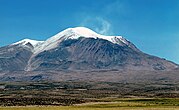Wikipedia:Today's featured article
|
Today's featured article Each day, a summary (roughly 975 characters long) of one of Wikipedia's featured articles (FAs) appears at the top of the Main Page as Today's Featured Article (TFA). The Main Page is viewed about 4.7 million times daily. TFAs are scheduled by the TFA coordinators: Wehwalt, Dank and Gog the Mild. WP:TFAA displays the current month, with easy navigation to other months. If you notice an error in an upcoming TFA summary, please feel free to fix it yourself; if the mistake is in today's or tomorrow's summary, please leave a message at WP:ERRORS so an administrator can fix it. Articles can be nominated for TFA at the TFA requests page, and articles with a date connection within the next year can be suggested at the TFA pending page. Feel free to bring questions and comments to the TFA talk page, and you can ping all the TFA coordinators by adding " |
Featured article candidates (FAC) Today's featured article (TFA):
Featured article tools: |
From today's featured article

Rumours is the 11th studio album by the British-American rock band Fleetwood Mac (two band members pictured). Released in 1977 by Warner Bros. Records, it was produced by the band with Ken Caillat and Richard Dashut. Following the band's 1975 album Fleetwood Mac, Rumours includes a mix of electric and acoustic instrumentation, accented rhythms, guitars, and keyboards. The lyrics, written in the aftermath of several breakups among the band members, concern personal and often troubled relationships. Rumours became the band's first number-one album on the UK Albums Chart and topped the US Billboard 200, supported by the singles "Go Your Own Way", "Dreams", "Don't Stop", and "You Make Loving Fun". It sold more than 40 million copies worldwide and garnered widespread acclaim from critics, with praise centred on its production quality and vocal harmonies. In 2020, Rumours was ranked seventh in Rolling Stone's list of the "500 Greatest Albums of All Time". (Full article...)
From tomorrow's featured article
Katana Zero is a 2019 platform game created by the indie developer Justin Stander. The player controls a katana-wielding assassin who can slow down time and predict the future, and must kill all enemies in a level without being hit. The story is told in sequences where the player converses with non-player characters through dialogue trees. Stander began working on Katana Zero in 2013 as his first commercial game. He sought to make a difficult story-driven game that minimized unskippable dialogue and cutscenes. He worked mostly alone during the prolonged development, although he recruited artists to design the visuals, and the musicians Bill Kiley and Thijs "LudoWic" Lodewijk to compose the synthwave soundtrack. Devolver Digital published Katana Zero for macOS, Nintendo Switch, and Windows on April 18, 2019. It sold 500,000 copies in less than a year and received positive reviews for its gameplay, visuals, writing, and music. Other ports are available, and downloadable content is in development. (Full article...)
From the day after tomorrow's featured article
Guallatiri is a stratovolcano in Chile that is 6,060–6,071 m (19,880–19,918 ft) high. It is located southwest of, or possibly within, the Nevados de Quimsachata volcanic group. The summit, surrounded by numerous fumaroles, may be a lava dome or volcanic plug, while the lower flanks of the volcano are covered by lava flows and lava domes. The volcano's eruptions have produced mostly dacite along with andesite and rhyolite. Past glaciation has left moraines on Guallatiri. A large eruption took place approximately 2,600 years ago. Guallatiri has been active since prehistoric times, with the latest known eruption in 1960. Fumarolic and seismic activity is ongoing and has resulted in the deposition of sulfur and other minerals on the volcano. It is covered by an ice cap above 5,500–5,800 m (18,000–19,000 ft) elevation that has retreated and broken up into separate ice bodies. Part of Lauca National Park, Guallatiri is monitored by the Chilean National Geology and Mining Service. (Full article...)



